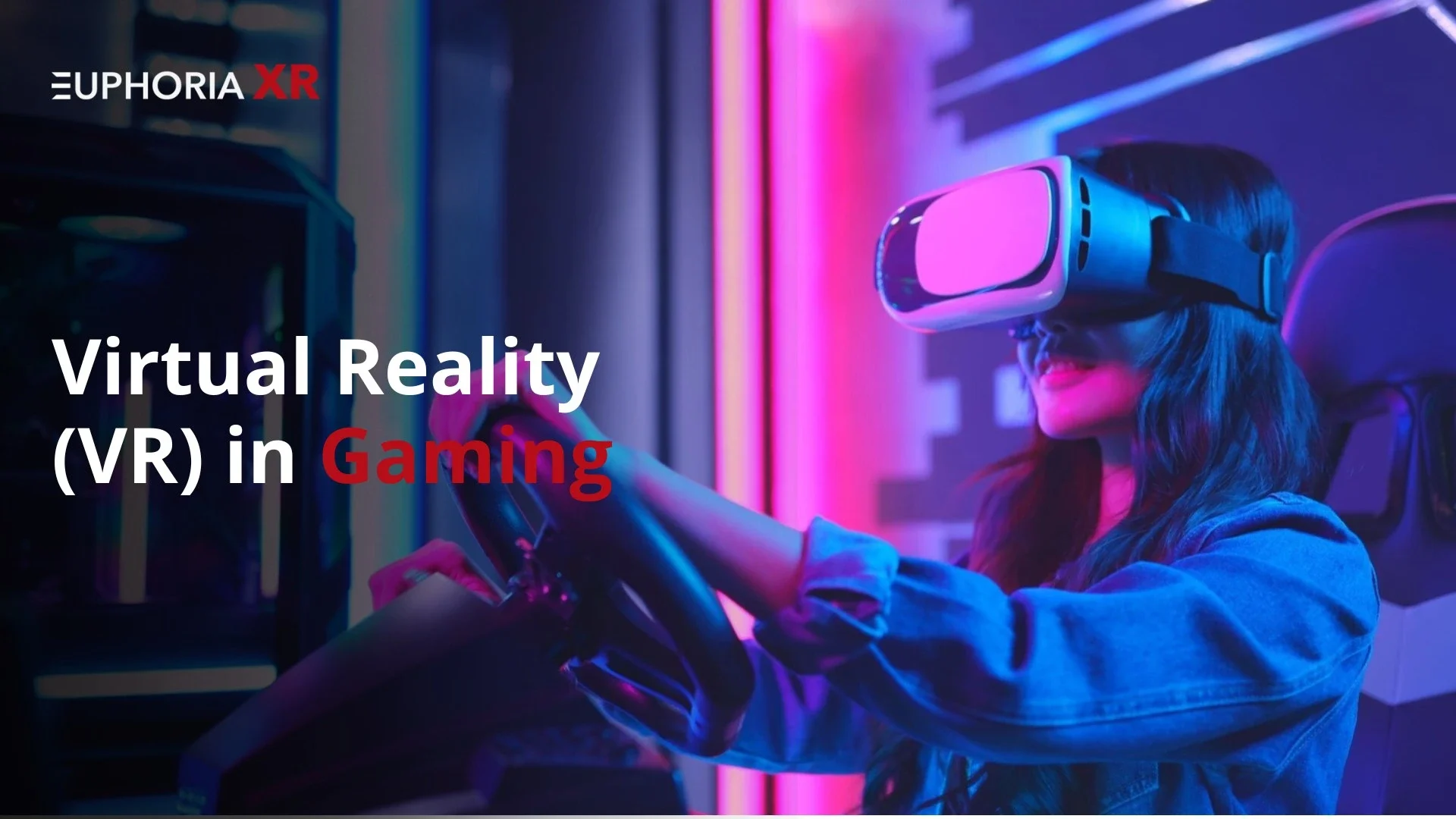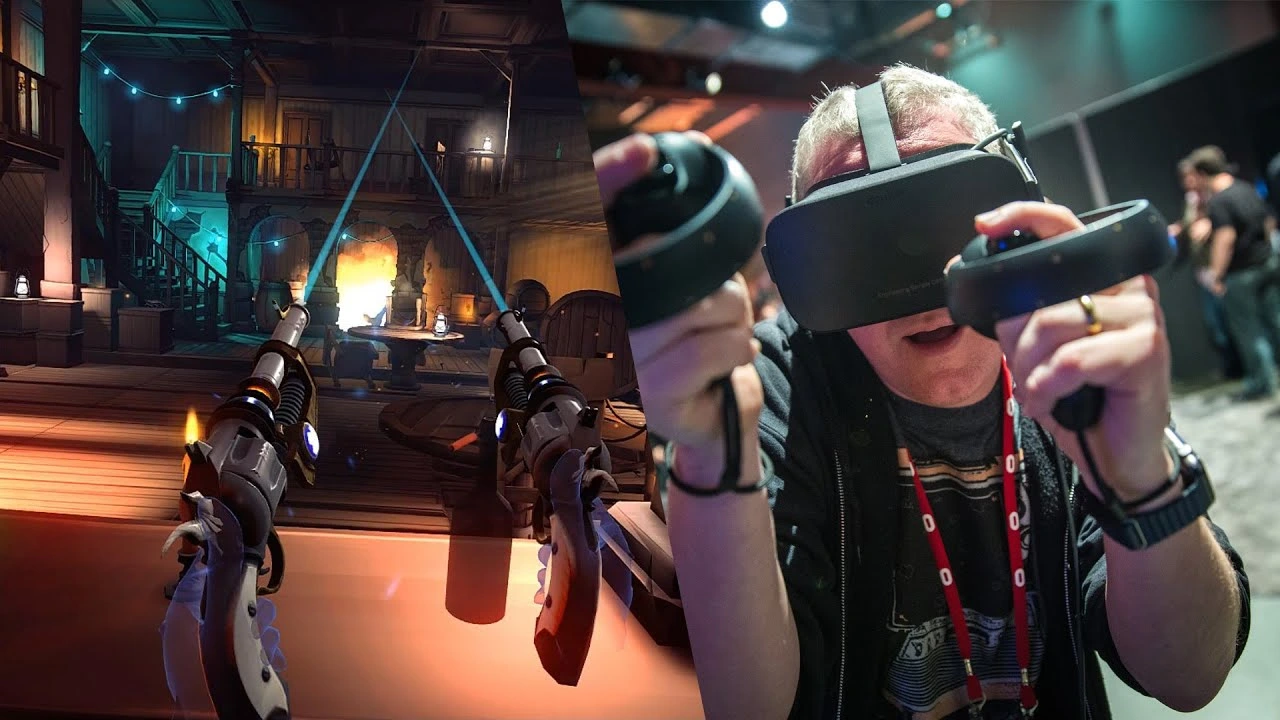Have you ever thought that playing video games is not as fascinating as it once was? The same old screen. The controller is the same. Even if you play, you do not feel as though you are playing the game.
Gaming may feel stale as a result of that disconnect. Additionally, it might be challenging for developers to maintain user engagement when the experience is not sufficiently immersive. There are a lot of games available, so it is easy for yours to be lost in the crowd.
This is where virtual reality in gaming comes in. It changes your gameplay, not just leveling it up. You are not only hitting buttons when using VR. The game is within you.
What is Virtual Reality in Gaming?
Virtual Reality (VR) in Gaming establishes a technology through hardware elements that create immersive gameplay experiences within simulated three-dimensional environments. Apart from standard console interaction through screens and controllers, VR in gaming allows players to physically join game environments with dedicated hardware such as headsets and peripheral motion controllers, optional handwear, and even treadmill devices.
Using a VR Headset and motion-sensing controllers to play a video game is known as virtual reality gaming. You are immersed in the virtual world rather than viewing your character from the outside. You feel as though everything you see, hear, and occasionally even touch is genuine.
Consider it this way: Playing traditional games is similar to watching a movie. Playing VR games is similar to being in a movie.
History and Evolution of VR Gaming
Although it may seem futuristic, virtual reality gaming has been around for many years. The first attempts to construct immersive digital worlds date back to the 1960s, when the “Sensorama” used sound, vibration, smells, and pictures to create a multisensory experience.
Businesses such as Sega and Nintendo experimented with virtual reality for home gaming in the 1990s. However, these early iterations failed because of their clumsy circuitry and poor graphics. For a while, virtual reality melted into the background.
The dream was finally realized in the 2010s when technology finally caught up. The Oculus Rift’s 2012 release reignited interest in virtual reality. The HTC Vive, PlayStation VR, and Meta Quest (formerly known as Oculus Quest) quickly followed. More immersive worlds, improved tracking, and fluid graphics were introduced with each generation.
VR gaming is not a niche anymore. VR gaming is changing how people play and create games, since global gaming revenue is predicted to surpass $12 billion by 2026.
How Does VR Gaming Work?
Fundamentally, virtual reality gaming creates the impression that you are “within” a digital world through the use of smart gadgets and real-time tracking. The following breakdown explains its operating system.
User Interaction and Movement
VR games react to your body’s movements. The virtual scene follows your head turning motions. When you walk forward, your virtual avatar corresponds. The technology performs this conversion through motion sensors combined with tracking systems, which convert body movements into virtual space data.
Sensory Inputs and Immersion
VR technology becomes entirely immersive because it specifically targets each human sense. The virtual headset provides complete visual immersion while the sound appears to come from every angle, along with haptic feedback that simulates physical contact, such as receiving a game hit. The enhanced experience of some systems achieves reality-based effects through scent and temperature control operations.
AI Algorithms Enhancing Gameplay
Virtual reality games receive their enhanced performance and improved abilities from artificial intelligence systems that operate in the background. The computer-controlled enemies react like real humans while interactive narratives reshape each decision, and the world changes based on player actions. AI functions as the source behind dynamic, lifelike gameplay elements, which draw players to the game repeatedly.
Role of Computer-Generated Graphics
Players using VR technology need 3D graphics with high resolution capabilities, which must function in real-time across their screen experience. The images need to refresh instantly during body or head movement because any delay in refresh rate produces a workflow disruption that leads to motion sickness. For VR gaming to run smoothly, strong computers and graphics cards are necessary.
Immersive Audio and Environments
The way you hear sounds can be just as important as background music for creating an immersive experience. Virtual Reality headsets replicate human audio perception through their implementation of spatial or 3D audio technology. Everything you perceive on the left side of your field of view will reach your left ear first. Virtual environments become more realistic because of their detailed audio inputs.
Read Also: https://euphoriaxr.com/metaverse-in-gaming-industry-the-future-of-gaming/
Key Components of a VR Game System
A few key pieces of equipment are required to play virtual reality games. Together, these elements allow you to be fully immersed in the digital world and engage with it naturally.
VR Headset
The headset stands as the primary component that powers your virtual reality system. The VR Headset provides virtual sight of the 3D environment by placing itself over your eyes. You can choose from Meta Quest 3, as well as HTC Vive, along with PlayStation VR2 to be your headset.
Motion Controllers
Handheld controllers enable device tracking of your hand movements to produce in-game interaction, which includes both grasping objects and making weapon swings alongside bow shots.
Sensors and Cameras
The equipment includes sensors and cameras built into headsets, along with receivers used for space detection, which are installed near the play area. The system determines your position and orientation because of these sensors.
Tracker
Trackers function as wearable accessories that enhance full-motion detection when integrated with advanced VR systems by mounting to the feet or hips.
VR Treadmill
A VR treadmill transforms your physical movements when standing while walking, or running in place to produce virtual character navigation. The VR setup especially benefits open-world exploration games through this function.
Haptic Suit
The wearable suit gives you physical sensations during gameplay. A gentle pulse or vibration emerges from the affected body part when you receive a hit during gameplay, making the experience more immersive.
Types of Virtual Reality (VR) Headsets
The three main types of VR headsets differ because they range between PC-connected tethers like Valve Index and standalone wireless models such as Meta Quest in terms of performance and cost, along with size factors.
Motion Controllers
The controllers that VR systems use provide unique functions among their characteristics through finger tracking, grip sensors, and button mapping capabilities. The precision, along with comfort, can be greatly improved by selecting the proper wearable accessory.
Tracking Systems
Different VR systems perform tracking either through dedicated base stations that rest outside the system or by using tracking technology integrated within the device. Your gaming will go more smoothly if the tracking is more accurate.
Haptic Feedback Devices
A variety of devices, such as vests, gloves, and footwear, are used to provide touch, pressure, and vibration sensations. Using this technology allows users to mimic real-world touching experiences within virtual environments.
Choosing the Right VR Gaming Equipment
People interested in purchasing virtual reality devices need to think beyond cost because they require equipment that suits their requirements best. Several factors need examination before conducting a purchase.
Compatibility and Requirements
Check that your selected headset operates on your current gaming machine or desktop computer. VR devices range from options that function automatically to systems that require powerful graphics processing units.
Display Resolution and Refresh Rate
Sharper images result from higher resolution. The motion sickness and smooth gameplay experience can be achieved by selecting a VR device with a quick refresh rate exceeding 90Hz.
Tracking accuracy and latency
Your movement seems more natural the shorter the latency and the better the tracking. Fast-paced games require such attributes to ensure they perform correctly.
Comfort and ergonomics
Being in the headset usually requires long stretches of wear. Examine gear that has light construction alongside customizable straps, as well as breathable padding.
Game library and platform support
Your headset needs to support the games you intend to play. Each headset requires use on particular systems, including SteamVR, Oculus Store, and PlayStation Network.
Enabling the upcoming wave of immersive training and gaming experiences.
Partner with EuphoriaXR right now.
Software Tools for Virtual Reality (VR) Game Development
Making virtual reality games requires more than just creativity; it also requires the appropriate equipment. To create immersive VR experiences from the ground up, developers use a mix of game engines, design applications, and management systems.
Game engines like Unity and Unreal Engine
The selection of game engines in the VR industry largely consists of Unity and Unreal Engine. Unity offers flexible and user-friendly features that make it particularly useful for independent developers working on their projects. Unreal delivers top-quality graphics, which makes it ideal for projects that require high-level visual graphics abilities.
SDKs for VR platforms
With a Software Development Kit (SDK), developers access tools that enable VR hardware communication with their game applications. Oculus SDK, along with SteamVR SDK and OpenXR, represent the main tools available in the market. The APIs and libraries offered by these tools provide support for tracking as well as audio functions and rendering capabilities.
Design and animation software such as 3ds Max and Maya
The development of life-like characters along with environments happens through the use of software products, 3ds Max and Maya. Developers can perform complex modeling as well as rigging operations, and animation through these tools.
Digital asset management tools
Struggling with 3D asset and code file management is a common issue for developers when developing their games alongside textural elements. Digital asset management tools provide team project and version control functionality for the proper organization of all digital assets.
Version control systems
Games continue to evolve, so developers must establish ways to follow changes in their development. Group collaboration becomes easier through software systems such as Git and Perforce, which ensure developers work without losing their work and preserve all their development progress.
Suggested Read: https://euphoriaxr.com/virtual-reality-development-software-2024
Types of Virtual Reality (VR) Games
Depending on the platform they are intended for, virtual reality games are available in a variety of formats. Each has advantages and disadvantages.
VR games for PC and laptops
The PC and laptop format of VR games represents the current pinnacle of graphics power paired with performance capabilities. Players who choose to experience depth in games like Half-Life: Alyx or Boneworks must meet high system requirements and use wired headset systems.
Console-based VR games
PlayStation VR, along with its upcoming version PSVR2, provides immersive gaming experiences through console-based gameplay. This type of game system functions immediately after connection while appealing to gaming audiences who own console hardware.
Mobile and smartphone VR games
The programming requires Google Cardboard and Samsung Gear VR devices that operate through smartphone systems. These systems provide basic VR functionality while remaining easy to reach by newcomers who want to experience VR.
Benefits of Virtual Reality (VR) in Gaming
Why, therefore, is virtual reality gaming becoming so popular? These are the main benefits that distinguish it from conventional gaming.
Deep immersive experience
Virtual reality places users inside the game world instead of offering them the standard view of it. All game sequences respond to your movements and sounds, so the experience becomes fully realistic.
New genres and gameplay innovations
VR serves as an inspiration for creative game formats that include rhythm slicing in Beat Saber and time-manipulating shooting in SuperHot, and fully interactive storytelling in various games.
Enhanced social interaction
Users can meet new people through games such as VRChat and Rec Room to interact through real-time 3D spaces by both chatting and playing games together. One similar concept exists to social media through a digital environment that replicates reality.
Encourages physical movement
Players must move during VR gameplay since sitting still is not an option in these virtual scenarios. Committing to gameplay requires body movement, so it becomes more energizing while also providing physical exercise benefits to fitness-oriented games.
Improved engagement and retention
Scientific data indicates that virtual reality games attract users to stay in the experience for longer durations since the immersive properties create strong addiction.
Top Virtual Reality (VR) Games in 2024
Do you need to find the top virtual reality games available this year? Virtual reality enthusiasts from both veteran and beginner gaming communities have found their new hallmarks in these exclusive titles on the market this year.
Beat Saber
The rhythm game lets you use your blade to destroy glowing blocks that follow the music soundtrack. Beat Saber delivers an energizing addiction that attracts players who want to exercise through its rhythmic motions.
SuperHot VR
The beautiful shooter controls time flow exclusively through your player’s movement. That means every action counts. Interacting in a virtual action film environment gives players a thrill of performing maneuvers under slow-motion methods.
Tetris Effect
This updated version of Tetris presents players with an extraordinary visual experience through a fully immersive musical score. Watching this game brings a blend of relaxation while showcasing beauty, along with a moving and profound experience.
No Man’s Sky VR
The game allows you to survey various worlds, construct instruments, defend against giants, and establish your interstellar stations. Periodic game updates result in a continuous growth of this title, which becomes increasingly impressive with every new release.
Resident Evil VR
The game offers a horrifying experience that appeals to fans of survival horror. In a residency sense, Resident Evil for VR delivers extraordinary frights because everything from groans to darkness to zombies appears completely authentic.
Best Virtual Reality Game (VR) Development Platforms in 2025
Creating a virtual reality game? These platforms are now the most popular options for developers. Everyone has advantages, but there are also some disadvantages to take into account.
Unity – what users like and dislike
What users like:
Users enjoy it because it is simple to use, has a large community, and works well with mobile and independent VR games.
What users dislike:
Large or graphically complex projects may have performance issues.
Unreal Engine – what users like and dislike
What users like:
Users enjoy the excellent visual programming tools, real-time rendering, and superb graphics.
What users dislike:
The steeper learning curve, particularly for novices or lone creators, is what users dislike.
3ds Max Design – what users like and dislike
What users like:
Often used in asset design, strong for 3D modeling and architectural aspects.
What users dislike:
Users find it costly for lone users and more taxing on system resources.
Maya – what users like and dislike
What users like:
Users appreciate the industry-standard rigging and animation tools, which are great for character design.
What users dislike:
Users dislike that it can be difficult and time-consuming to learn.
Amazon Lumberyard – what users like
What users like:
Users enjoy that it is free, works with AWS and Twitch, and is suitable for multiplayer virtual reality gaming.
What users dislike:
Users complain that there are fewer learning resources than Unity or Unreal, and the user community is smaller.
Challenges in Virtual Reality (VR) Game Development
Although virtual reality has intriguing opportunities, developing VR games presents its own set of challenges.
High development costs
Game developers need additional financial resources and specialized staff abilities, along with extended time commitments, to build VR titles specifically for premium graphics and motion capture solutions.
Hardware limitations
The VR equipment market will not reach full saturation even during the year 2025. Video game developers need to make their products work efficiently on devices having different specification levels, together with different control options.
Motion sickness and fatigue
Users experience dizziness and tiredness when they encounter slow frame rates, in addition to abnormal motion or delayed tracking. Programmers must concentrate on developing gameplay that delivers both convenience and comfort.
Accessibility and adoption barriers
VR is not inclusive yet. The industry faces an essential hurdle in delivering universal accessibility because of the barriers that exist regarding cost and physical capabilities.
We have assisted companies in introducing remarkable virtual reality experiences. You’re next.
The Future of Virtual Reality (VR) in Gaming
Virtual reality has advanced significantly, although developers expect much better outcomes for future implementations. Technology advances continue to bring forth new developments that can be predicted.
Advancements in graphics and processing
Coming VR headsets will produce graphics that appear even more real compared to current technology. Games will achieve maximum realism because leading GPU technologies and foveated rendering work together with eye-tracking capabilities to deliver sharp and fluid visual experiences.
More realistic haptics and wearables
Participants can find upcoming enhancements in haptic suits, haptic gloves, and haptic footwear. Future virtual experience devices will advance their feedback capabilities to allow users to feel both virtual textures, collisions, and temperature shifts.
Cross-platform VR ecosystems
Gaming alone is becoming less popular. Customers accessing VR with PlayStation systems will soon be able to freely connect and play with users equipped with either Meta or PC devices. The standard will change toward interconnected virtual spaces accessible to all users.
Integration with AI and the metaverse
Artificial intelligence systems will enable Virtual Reality Gaming to become more intelligent through behavior analysis, which allows for challenge customization, organic dialogue creation, and dynamic world creation. The expansion of the metaverse alongside these developments results in personal and continuous virtual experiences for all users.
Wrapping Up!
Virtual reality in gaming is a revolution, not only a trend. VR is transforming how we play, create, and interact with intelligent, AI-driven worlds, full-body mobility, and immersive visuals.
Now is the perfect time to get started, whether you are a developer hoping to create the next blockbuster game or a player hoping to discover new worlds. VR will influence entertainment in ways we can not yet fathom as the technology becomes more potent and widely available.
Are you prepared to face the future? Put on a headset and start playing the game.
















